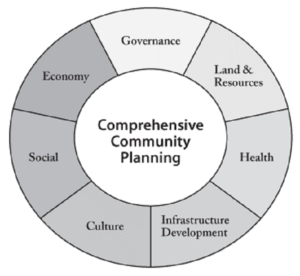Opinion: Comprehensive Community Planning for Successful Economies
 Submitted by the Anishinabek Nation Economic Development Department
Submitted by the Anishinabek Nation Economic Development Department
Our exploration of economic development has taken us to the micro-level of the entrepreneur – the individual – and what growing the economy means for you, the community member. We will now take a step back to consider the community as a whole and how leaders and technicians plan to build and grow sustainable economies that will also foster sustainable communities and fulfilling lives for members.
When we think about economic development, there are so many directions from which we can approach the topic. We can consider the needs and benefits to the individual business owner, the collateral benefits and effects on the community, and the long-term sustainability and supports that development will provide and require. All of these components are vital and of value, but if we want to view the community as a whole, considering a holistic approach to community development through Comprehensive Community Planning is where we might want to start.
First off, what is Comprehensive Community Planning? Indigenous Services Canada defines it as “an ongoing process that enables a community to plan its development in a way that meets the needs and aspirations in all aspects of community life”. By planning, we can ensure that the direction and development of the community are based on informed decisions with input from all of those who are affected by it. We can build stronger; and more supportive, healthy, and sustainable economies within our communities when we match economic development planning with our community goals. Not to be overlooked is the word “ongoing” in the definition; community plans will and should change—growing and adapting to the needs of the community, members, and trends within the greater economy.
Why does Comprehensive Community Planning work? Well, the long and short of it is in the very nature of the process. We take stock of what we have and where we want to go. Input is community-driven and garnered from all parts of our citizenship, considering our past (community history), present, and what we will have in place for generations in the future. It involves and engages everyone, fostering development in a way that serves the community, building upon the goals and needs of the community as a whole, and providing opportunities and supports for those interested in developing businesses. It incorporates the immediate needs within a community for products, services, and income streams with the long-term goals and visions for socioeconomically and environmentally sustainable nations. It also allows for long-range planning that can assist leadership in developing opportunities for future acquisitions, connections, and resources that will be needed to meet those goals with foresight and accountability measures ready to meet the demands as they arise.
Through the lens of economic development, Comprehensive Community Planning helps identify the economic areas requiring attention, exploring the current needs, revenue streams and potential barriers, and ensuring that the supports and resources needed can be made available. For example, you notice a rise in citizens offering professional or health services; in order for them to offer services within your community, you may need to consider developing a business centre so that office space is available. If your planning identifies natural resources as being an area of interest for development and participation, it opens the door for planning to acquire land, support existing businesses/new startups in acquiring training and equipment, and more.
Having policies in place prior to the business implementation ensures that community environmental concerns and policies are in place before work begins. Furthermore, it is important to look ahead to meet the needs for potential employment opportunities. If work is available, will you have the infrastructure, housing, education, and social supports that will allow for citizens to live in and work in the community?
The why might be clear, but what about the how?
Identifying the planning team is an important first step. Having a group that will be able to start, plan, drive, and follow-through for the entire process is key. This group should represent several important components: technical support, leadership, and people who understand the resources and administration of the community. There is growing support to have the majority of the planning team comprised of committed community members since they are the ones most directly impacted by issues and the consequences of any implementation.
The next step is larger-scale community engagement. No plan can be comprehensive without this very important part. From there, we would move to develop capacity for the planning team, leadership, technical staff, and administrative participants. As capacity is developed and community engagement progresses, goals can be determined, timelines identified, implementation strategies developed, and delegation plans created to follow through on implementation.
Now, the key here is to remember that a Comprehensive Community Plan is meant to be a living document. That means that once we start implementation, we do not stop there. Instead, we monitor, adjust, engage the community, evaluate the plans against the growing and changing needs and goals of the community, and build upon that.
While this is a simple summary of what a Comprehensive Community Plan is, it is important to recognize that community involvement and ownership over a plan are key to having successful results. It is also a key method of building the communities’ sense of ownership, buy-in, and pride, from which sustainable and successful communities are created.
For further reading on Comprehensive Community Planning:

